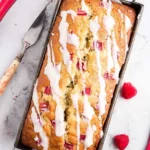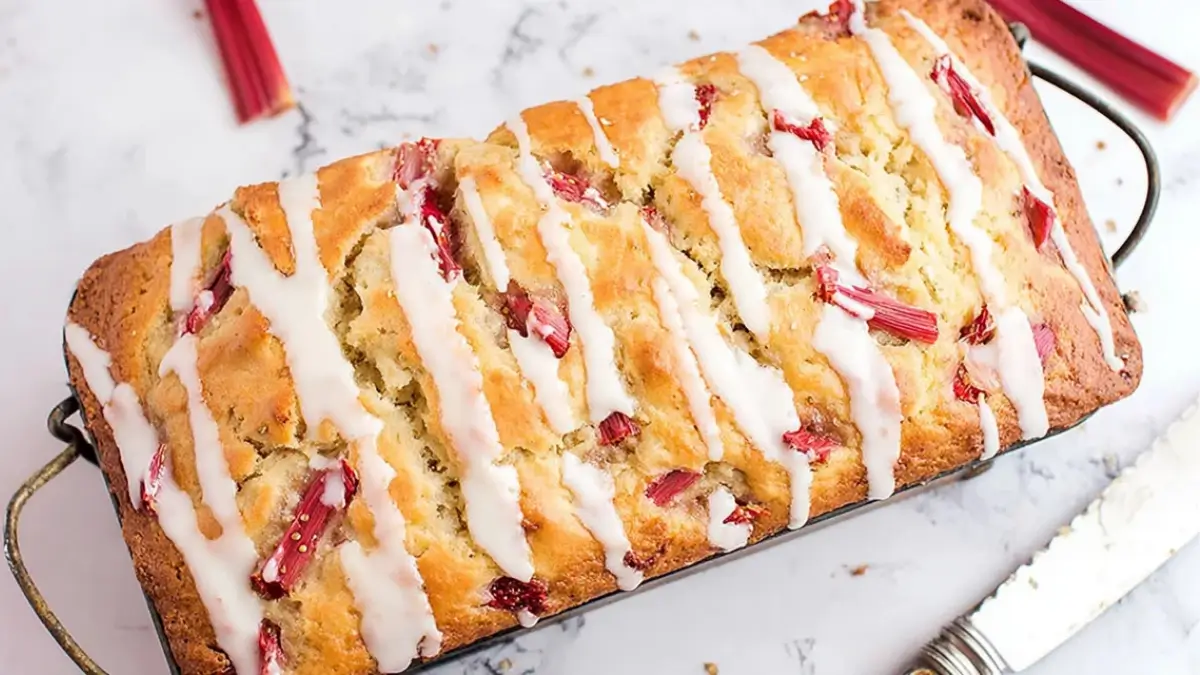There’s something truly nostalgic about the smell of warm bread wafting through the house, especially when it’s this incredibly moist and gently tart rhubarb bread. My grandmother used to make a version of this every spring when rhubarb came into season. As a child, I’d help her pick stalks from the backyard, carefully avoiding the leaves she warned me were “no good.” It was one of the first recipes I helped her with—and one of the first I ever baked solo. This rhubarb bread recipe is the perfect gateway for new bakers: it’s easy to make, quick to prep, and delivers a delicious balance of sweet and tangy in every bite.
It also makes for a fantastic quick and healthy meal idea—perfect with coffee for breakfast, as an afternoon snack, or even dessert. With no yeast, no waiting, and no complicated steps, it’s the definition of beginner-friendly baking.

Why This Rhubarb Bread Recipe is Special
This easy sheet pan dinner-style bread (yes, it bakes in a single loaf pan!) stands out for its balance of flavor and texture. The rhubarb provides little bursts of tartness that contrast beautifully with the sweet base and light citrusy glaze. What’s more, this lemon herb chicken recipe-style technique—layering bright flavors and baking simply—makes it not just flavorful but fast. Best of all, the ingredients are pantry staples, and you can easily swap them based on what you have. It’s a quick and healthy meal for your sweet tooth.
Ingredients and Preparation
Granulated Sugar
Adds sweetness and helps tenderize the crumb. You can use coconut sugar or honey (though that will alter the texture slightly).
Orange Zest
Adds brightness and a subtle citrus aroma. If you don’t have oranges, lemon zest works wonderfully too.
Vanilla Extract
Deepens the overall flavor. Almond extract could also be used for a different twist.
Vegetable Oil
Keeps the bread moist and soft. You can substitute with canola or melted coconut oil.
Milk
Gives moisture and lightens the batter. Plant-based milks like almond or oat work just as well.
Eggs
Bind the bread and add richness. For an egg-free option, use a flaxseed egg or applesauce.
All-Purpose Flour
Forms the structure. For a gluten-free version, use a 1:1 GF baking flour.
Salt
Balances sweetness and enhances flavor.
Baking Powder
Lifts the bread, making it airy and soft.
Fresh Rhubarb
The star of the dish—adds tang, moisture, and fiber. Frozen rhubarb can be used, but thaw and pat dry before mixing in.
Powdered Sugar, Heavy Cream, and Orange Oil (for glaze)
The glaze adds a glossy, sweet finish. You can skip this or replace with a lemon glaze or just a sprinkle of sugar on top.
Step-by-Step Instructions
Step 1
Preheat your oven to 350°F and prepare a 9×5-inch loaf pan by greasing it or lining it with parchment paper.
Step 2
In a large mixing bowl, whisk together the sugar, orange zest, vanilla extract, vegetable oil, milk, and eggs until fully blended and smooth.
Step 3
In a separate bowl, sift the flour, salt, and baking powder together to ensure even distribution of leavening.
Step 4
Wash and pat dry your rhubarb stalks, then dice them into ½-inch pieces. You don’t need to peel them—just avoid using the leaves or roots, which are not safe to eat.
Step 5
Gently fold the dry ingredients into the wet mixture until just combined. A few lumps or streaks of flour are okay—overmixing at this stage can make your bread tough.
Step 6
Add the chopped rhubarb into the batter and stir gently until evenly distributed, being careful not to overwork the mixture.
Step 7
Pour the batter into your prepared loaf pan, smoothing the top gently with a spatula.
Step 8
Bake for 55–60 minutes, or until a toothpick inserted in the center comes out clean. If the top browns too quickly, loosely tent with foil during the last 10–15 minutes.
Step 9
Let the bread cool in the pan for 10 minutes, then transfer to a wire rack to cool completely.
Step 10
While the bread cools, whisk together the powdered sugar, heavy cream, and orange oil for the glaze. Adjust consistency by adding more cream or sugar as needed.
Step 11
Once the bread is cool, drizzle the glaze over the top. Make sure the bread is on a rack to catch any extra glaze and avoid a sticky puddle underneath.
Beginner Tips and Notes
- If your rhubarb is particularly thick or stringy, cut it in half lengthwise before dicing to avoid chewy bits.
- Avoid overmixing the batter once the flour goes in; gentle folding preserves tenderness.
- If you don’t have a sifter for dry ingredients, simply whisk them together thoroughly to break up clumps.
- To make prep faster, pre-chop your rhubarb and zest citrus ahead of time and store them in the fridge.
Serving Suggestions
This bread pairs beautifully with a dollop of Greek yogurt or a slather of softened butter. Serve it alongside coffee or a chai latte for a cozy morning treat. For a fuller breakfast, add some scrambled eggs or fresh fruit on the side.
Leftovers? No problem. Wrap slices in plastic wrap and store at room temperature for up to 4 days. It also freezes well—wrap tightly and store for up to a month. Just reheat in the microwave or toaster oven before serving.
Conclusion
Rhubarb bread is the kind of quick and healthy meal that feels both nostalgic and fresh, and it’s ideal for beginner bakers looking to try something new without the stress of complicated techniques. If you’ve been searching for an easy sheet pan dinner-style bake or a lemon herb chicken recipe alternative for your sweet tooth, this loaf is a must-try. I’d love to hear how yours turns out—share your baking adventures or ask questions in the comments. Let’s keep making cooking fun and fearless.
FAQ About Rhubarb Bread
1. Can I use frozen rhubarb instead of fresh?
Yes, frozen rhubarb works well in this recipe. Just thaw it completely and pat it dry with paper towels before adding it to the batter to avoid excess moisture.
2. Why is my rhubarb bread too dense or heavy?
Overmixing the batter once the dry ingredients are added can result in a dense loaf. Fold gently until just combined and avoid smoothing the batter too much in the pan.
3. How do I know when the rhubarb bread is done baking?
Insert a toothpick into the center of the loaf—if it comes out clean or with just a few moist crumbs, the bread is ready. Check around the 55-minute mark to avoid overbaking.
4. Is it safe to eat rhubarb raw or in baking?
The stalks of rhubarb are perfectly safe to eat raw or cooked. However, never eat the leaves or roots, as they contain oxalic acid and are toxic.
More Relevant Recipes
Print
Best Rhubarb Bread
- Total Time: 1 hour 15 minutes
- Yield: 1 loaf
- Diet: Vegetarian
Description
A moist, sweet, and tangy rhubarb bread that’s beginner-friendly and perfect for spring. Quick to make, with simple steps and pantry ingredients.
Ingredients
- 1 cup granulated sugar
- 1 teaspoon orange zest
- 2 teaspoons vanilla extract
- ½ cup vegetable oil
- ¾ cup milk
- 2 large eggs
- 2 cups all-purpose flour
- ½ teaspoon salt
- 1½ teaspoons baking powder
- 2 cups fresh rhubarb, diced
- ½ cup powdered sugar (for glaze)
- 2 to 3 tablespoons heavy whipping cream (for glaze)
- 1 to 2 drops orange oil (for glaze)
Instructions
- Preheat your oven to 350°F and prepare a 9×5-inch loaf pan by greasing it or lining it with parchment paper.
- In a large mixing bowl, whisk together the sugar, orange zest, vanilla extract, vegetable oil, milk, and eggs until fully blended and smooth.
- In a separate bowl, sift the flour, salt, and baking powder together.
- Wash and pat dry the rhubarb stalks, then dice them into ½-inch pieces.
- Gently fold the dry ingredients into the wet mixture until just combined. Do not overmix.
- Stir in the diced rhubarb until evenly distributed throughout the batter.
- Pour the batter into your prepared loaf pan and smooth the top.
- Bake for 55–60 minutes or until a toothpick inserted in the center comes out clean.
- Let the bread cool in the pan for 10 minutes, then transfer to a wire rack to cool completely.
- Whisk together powdered sugar, heavy cream, and orange oil for the glaze. Adjust consistency as needed, then drizzle over the cooled bread.
Notes
- Do not eat rhubarb leaves or roots—they are toxic.
- Use vegetable oil instead of butter for a moister texture.
- Overmixing after adding flour can result in tough bread.
- If the top browns too quickly, cover loosely with foil during the last 10–15 minutes of baking.
- Let bread cool fully before glazing to prevent melting and mess.
- Prep Time: 15 minutes
- Cook Time: 55–60 minutes
- Category: Quick Bread
- Method: Baking
- Cuisine: American
Nutrition
- Serving Size: 1 slice
- Calories: 147
- Sugar: 17g
- Sodium: 89mg
- Fat: 2g
- Saturated Fat: 1g
- Unsaturated Fat: 2g
- Trans Fat: 1g
- Carbohydrates: 30g
- Fiber: 1g
- Protein: 3g
- Cholesterol: 27mg

